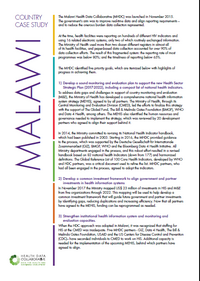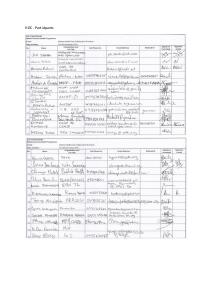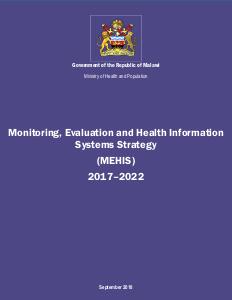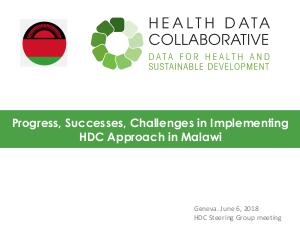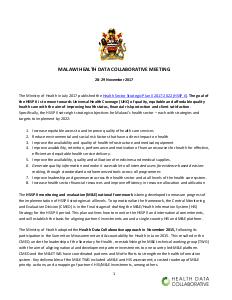Malawi
Overview
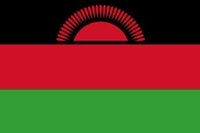
The Ministry of Health of Malawi is committed to supporting global efforts to increase accountability and improve data quality for decision-making. A team from the health ministry participated in the Summit on Measurement and Accountability for Results in Health in June 2015. At the Summit, over 600 global health leaders, decision-makers, thought leaders and implementers from over 60 countries representing development partners, partner country governments, and civil society endorsed the Roadmap for Health Measurement and Accountability and 5-Point Call to Action.
Progress
Malawi and partners collaborated to develop the M&E framework of its second health sector strategic plan, including a compact list of national core health indicators. Malawi, when selecting indicators to be included in the M&E framework, began with an overwhelming list of 195 indicators. Supported by GIZ /EPOS Health Management, The Bill & Melinda Gates Foundation, WHO and the Bloomberg Data for Health Initiative, the Malawi Ministry of Health and Population used the Global Reference List of 100 Core Health Indicators, developed by WHO and HDC partners, to refine the list down to 82 indicators. By engaging partners and programmes in the process, all MHDC partners agreed to adopt the indicators. This compact list will reduce the burden of data collection and improve data quality.
Key HIS/M&E documents developed by the country include:
- Malawi Monitoring & Evaluation Task Force Priorities 2017-2021
- Malawi National Health Information System Policy
- Malawi Health Sector Strategic Plan II 2017-2022 (HSSP II)
- Malawi Monitoring, Evaluation and Health Information Systems Strategy (MEHIS) 2017-2022
- Malawi National Health Indicators Handbook
Malawi Ministry of Health Data and Digital Priorities 2021
Key priorities
Develop the M&E component of the new Health Sector Strategic Plan (HSSP II)
Develop a Common Investment Framework
Strengthen institutional HIS/M&E capacities
Reconfigure and expand DHIS 2 functionalities
Increased accountability of the MoH and health development partners by expanding public access to health data
Key documents
Activities & milestones
August 2018
Ministry of Health plans annual Malawi HDC meeting
The Ministry of Health is planning to hold the annual Malawi HDC meeting with partners the week of 5 November. Draft agenda to follow.
May 2018
Strengthening the Ministry of Health's M&E capacity
One of the key priorities of the Malawi HDC is to strengthen institutional health information system and monitoring and evaluation (HIS/M&E) capacities. Recognizing that staffing for HIS at the Ministry of Health has been inadequate, five HDC partners -- GIZ, Data 4 Health, The Bill & Melinda Gates Foundation, USAID and CDC -- have seconded individuals to the ministry to work on HIS. Additional capacity will be needed to support implementation of the forthcoming M&E/HIS Strategy, behind which partners have agreed to align.
November 2017
Strengthening governance and coordination of health data investments in Malawi
Partners of the Malawi Health Data Collaborative met on 28 November 2017 at the Golden Peacock Hotel in Lilongwe, Malawi. The Ministry of Health’s Central Monitoring and Evaluation Division (CMED) convened the meeting to (i) review the draft Monitoring and Evaluation/Health Information System (M&E/HIS) Strategy 2017-2022, (ii) identify areas for technical and financial support from partners, (iii) discuss and identify next steps to finalize the M&E/HIS Strategy 2017-2022 and the common investment framework; and (iv) review technical updates on M&E priorities (successes, barriers to overcome, challenges, etc.).
Seventy-nine participants attended the meeting, representing some 20 organizations including Alliance for Public Health; BMGF; CDC; Cooper/Smith; Data for Health (Bloomberg Philanthropies); DFID; GiZ; Johns Hopkins University; Luke International; Palladium; Partners in Health; Partnership for Maternal, Newborn & Child Health; PEPFAR; Population Services International; The Global Fund; Unicef; University College London; and USAID.
As a key part of the process of finalizing the M&E/HIS Strategy by March 2018, CMED and partners recognized that further support is needed to define concrete ways of strengthening governance, leadership and coordination of investments in M&E/HIS. This would include defining the full set of skills and capacities needed within CMED to take full ownership and leadership in implementing the strategy.
To address this emerging priority, the Secretary for Health will assess various options for strengthening CMED capacity to coordinate the increasing influx of funds. The mapping of partners’ M&E/HIS investments is also critical to support the management of these funds. Thus the HDC approach is providing a platform for developing country-led governance of data and of investments in data.
November 2017
HIS/M&E investments in Malawi mapped thus far total USD23.1 million
In the weeks preceding the Malawi HDC meeting on 28 November, a preliminary mapping of HIS/M&E investments (see page 4 of the meeting summary) was conducted, with global partners providing a short summary of their investments against the nine objectives of the draft M&E/HIS Strategy. (Note that Objective 6 of the new Health Sector Strategic Plan, with the aim to “generate quality information and make it accessible to all intended users for evidence-based decision-making,” is estimated to cost approximately USD74 million for the 2017-2022 period.) This mapping will be used to help develop a common investment framework that will guide future government and partner investments by identifying gaps, reduce duplications and eventually increase efficiencies.
Below are some findings from the mapping exercise:
- 5 partners provided information on their investments (BMGF, D4H, GAVI, TGF, and WHO).
- Investments from the 5 partners total USD23.1 million through 2022, and their 82 activities were mapped against the nine objectives of the strategy and its 164 activities.
- Largest investments are in objective 5 (improve alignment of fragmented data sources around a single country-led M&E platform), objective 6 (strengthen data sources to ensure that SDG and HSSP II indicators can be measured) and objective 8 (improve availability, analysis, dissemination and use of data for decision making).
To complete the mapping by March 2018, the Ministry of Health is currently gathering additional investments of other partners as well as extracting information on HIS/M&E investments from the MoH’s resource tracking database.
October 2017
Ministry of Health Plans High-Level HDC Forum
The Ministry of Health will host a national multi-stakeholder HDC workshop, led by the Chief of Health Services, on 28 November 2017 to validate a new HIS strategy, present the finalized National Health Indicators, and seek partner support and alignment of investments behind the M&E priorities. For more details, please contact Simon Ndira (simon.ndira@giz.de).
September 2017
Ministry of Health Finalizes National Health Indicators
The list of core indicators, which are essential to the monitoring and evaluation framework of Malawi's second health sector strategic plan (HSSP II), was developed by the Central Monitoring and Evaluation Division (CMED) of the health ministry with support and collaboration from Bloomberg Philanthropies’ Data for Health initiative, GIZ-funded EPOS, Bill & Melinda Gates Foundation, and WHO.
June 2017
Ministry of Health Finalizing New HIS Strategy
The Ministry of Health’s Central M&E Division (CMED) held a retreat, supported by Bloomberg Philanthropies’ Data for Health initiative, in early June to finalize a new Health Information System (HIS) strategy, aligned with the new Health Sector Strategic Plan (HSSP II). A draft of the document is currently being prepared and will soon be shared with the Malawi HDC working group.
May 2017
Harmonized Data Quality Tool Improves Efficiency of Activities in Malawi
Implementation of a harmonized Data Quality Review (DQR) toolkit is improving the efficiency of partners’ activities in Malawi. The tool, developed by WHO with support from partners, aims to harmonize multiple disease- and donor-specific data quality tools and review processes. Given The Global Fund plans to implement the tool in Malawi including immunization indicators, a standalone data quality review for the Expanded Programme on Immunization (EPI), which GAVI planned to support, is no longer needed this year. This allows GAVI to re-allocate the funds toward other activities planned for 2019.
February 2017
Draft Mapping of HIS/M&E Investments
Ministry of Health, WHO and other partners have been mapping current HIS/M&E investments in Malawi. These results will inform the common investment framework, designed to align technical and financial assistance with country-defined priorities, reduce fragmentation and duplication of efforts and lower the burden of reporting. So far, responses have been received from 16 partners. A second round of inputs will target additional global partners to complete the mapping before validation.
The Gates Foundation and the Global Fund are now working jointly to explore how the Global Fund’s catalytic funding mechanism for data systems could be tapped to support the M&E priorities. Similarly, GAVI is now developing its new Country Engagement Framework and is referring to the costed M&E priorities to explore how GAVI can back them.
MoH is preparing to hold a multi-stakeholder workshop in the second quarter to validate the mapping of investments and common investment framework.
December 2016
Health Partners Support MoH to Reconfigure DHIS2
GIZ, University of Oslo, WHO, UNICEF, and other U.S. partners have been supporting the health ministry to reconfigure DHIS2 to include both programme-specific dashboards and broader groupings such as primary healthcare indicators, universal health coverage indicators, and national core indicators. New programme-specific dashboards were tested in mid-December, moving toward the goal of making the revamped DHIS2 system accessible through an open-access data portal (Malawi Health Observatory) by mid-2017.
November 2016
MoH Holds Workshop to Finalize National Health Indicators
Malawi’s Central Monitoring and Evaluation Division (CMED) of the health ministry held a workshop November 2-3 to finalize the list of national core health indicators, with support and collaboration from Bloomberg Philanthropies’ Data for Health initiative, GIZ-funded EPOS, Bill & Melinda Gates Foundation, and WHO. The list of core indicators are essential to the monitoring and evaluation framework of Malawi's second health sector strategic plan (HSSP II), currently being developed. Through the workshop, feedback was gathered from 40 representatives from across the health ministry and partners to produce a new draft of the National Health Indicators handbook, to be finalized by year-end. Two consultants have also been updating the M&E priority actions to track health sector performance and mapping government and partners’ commitments toward the priority actions and financial gaps.
October 2016
Gates Foundation, World Bank Align Investments With Malawi’s M&E Priorities
The Bill and Melinda Gates Foundation is making a USD10m investment over 4 years, focusing on strengthening routine information systems, improving use of data and governance in 10 districts. These areas align with M&E priorities identified by Malawi’s Ministry of Health. In addition, the foundation is now seeking co-investments to expand the project programmatically (beyond HIV) and geographically (beyond the 10 districts). Similarly, the World Bank will fund priority M&E activities that will be financed from its ongoing Nutrition and HIV Project.
October 2016
Renewed efforts to finalize the M&E pieces of the HSSP II
The Ministry of Health nears completion of its new Health Sector Strategic Plan (HSSP II) with a pool of consultants developing the systems components (e.g. human resources and health infrastructure). In tandem, Vital Strategies, Bill & Melinda Gates Foundation, GIZ, WHO and other partners are supporting finalization of the M&E framework, including the national core indicators, and the M&E priority actions to track health sector performance against the plan, including government and partners’ commitments toward the priority actions and financial gaps. These will form the basis of the investment framework, and it should be finalized in parallel to the completion of the HSSP II.
Final outputs are expected by November, 2016.
September 2016
Evaluation of GiZ Malawi Health Programme
A team of independent technical experts and development partners including BMGF visited Malawi to evaluate the Malawi German Health Programme, which comes to an end by the end of 2016 and to assess whether the objectives have been met and what results were achieved. The team reviewed reports and documents, visited district hospitals, medical colleges, and meet with government representatives and development partners including USAID, CDC, DFID, WHO and UN organisations.
The results of the evaluation, which will be available soon, will provide inputs and recommendations into the design of the next 3 year phase of the Malawi-German Health Programme which will be aligned with the national Health Sector Strategic Plan II (2016-2021) and the M&E priority actions.
June and July 2016
Costing of the M&E priority actions
In June 2016, an international consultant hired by WHO supported the costing of the M&E/HIS priority actions. This exercise fed on the efforts to cost the new HSSP; and will be the basis of the M&E common investment framework. This first attempt to cost the M&E priority actions was followed by another mission supported by UNICEF to cost specific priority actions (i.e., surveillance).
Also, in parallel CHAI is conducting a mapping of partners’ investments in the health sector, including M&E/HIS. The costing of M&E priority actions and the mapping of partners’ investments will converge in the common investment framework. MoH will continue working jointly with partners to finalize the costed M&E plan, based on an iterative process, to ensure alignment with the HSSP.
May 2016
Progress with re-configuration of DHIS2
In May 2016, the central data repository was being migrated to the MOH server residing at Community Health Services Unit (CHSU). In performing the migration, a dedicated team of technicians have been reconfiguring the application to ensure the new instance can benefit from all features of DHIS2. The configuration process is spearheaded by CMED and the ICT Unit of MOH; however, other actors are involved in gearing the process including GIZ through EPOS, BMGF through Kunika Project, CDC through Baobab Health Trust, Health Information Systems Programme (HISP) in collaboration with Oslo University with support from Global Fund. The team has been migrating data programme by programme.
April 2016
Technical assistance provided to MoH to identify M&E priority actions and national core health indicators
MOH requested specific technical assistance to WHO to update the M&E roadmap of the M&E task-force; to identify the M&E priority actions and map the current M&E/HIS interventions of MoH and health development partners; and to initiate the discussions on the national core indicators. The technical assistance mission produced sound drafts of the M&E priority actions; and the M&E core indicators of the HSSP II. These documents will be the basis of the common investment framework. Next steps identified during the TA mission included to conduct a deeper assessment of the RHIS ; and to cost the identified priority actions.
March 2016
Assessment of barriers and opportunities for investment on a unified system for M&E
To leverage current momentum and interest at country level to strengthen the national M&E platform, Global Fund commissioned a report to assess the current gaps and barriers that impede realization of a unified platform and requested recommendations for strategic investments. The report will be a useful input to the work ongoing at CMED to develop a costed M&E plan for the next HSSP.
February 2016
Work continues to develop the new Health Sector Strategic Plan
The MoH and the HSSP II development team continued to develop the conceptual framework for the new HSSP II. Principles and pillars are drafted. Also, the Ministry of Health formally appoints members to the M&E task force, which includes members from health development partners (GiZ, CDC, USAID, PMI, CDC, WHO and UNICEF, among others).
January 2016
Situation analysis of the new Health Sector Strategic Plan finalized
One of the key priorities identified by MoH for 2016 was to develop the new Health Sector Strategic Plan (HSSP II), which is going to guide the implementation of helath interventions at country level; and guide the investments in health.
The MoH presented the situation analysis of the HSSP II in January 2016, and activated the working groups to finalize the plan, which will include a M&E framework.
December 2015
MoH Malawi M&E taskforce created
As follow-up of the Multi-partner mission the previous month, the MoH Malawi created the M&E task force. The general objective of the M&E Taskforce is to fully align investment, i.e. the national and development partner investments in health with a single country platform for information and accountability, by coordinating the implementation of the short- and medium term priority tasks outlined during the WHO and Partners mission to Malawi in November 2015
November 2015
Multi-partner mission to support to Malawi in strengthening the MOH M&E platform
Partners from seven agencies conducted a joint multi-partner mission to Malawi to raise the profile of post-2015 agenda, including SDGs and the global effort in strengthening country-led platforms for information and accountability; and to provide inputs to and strategic guidance for the development of the national M&E plan.
As a result of the mission, a roadmap of priority actions was drafted, to guide the next steps to strengthen the M&E platform, and to finalize the M&E framework of the upcoming HSSP II (Helath Sector Strategic Plan)


